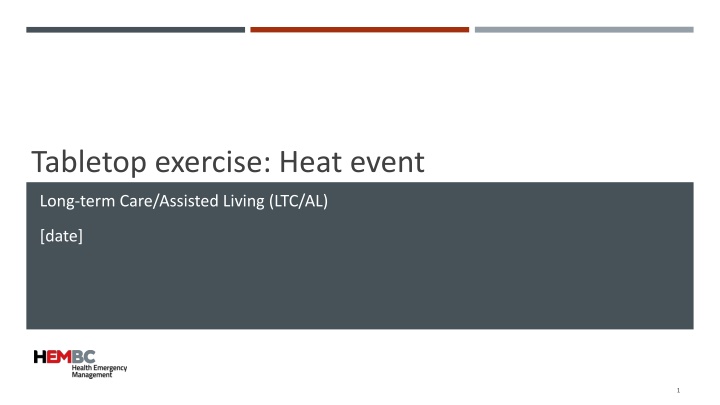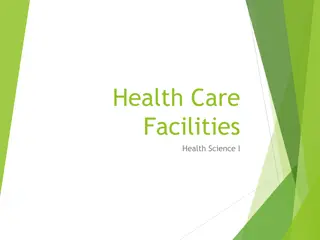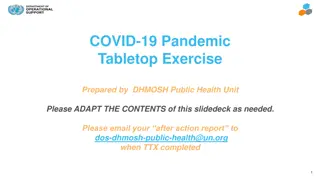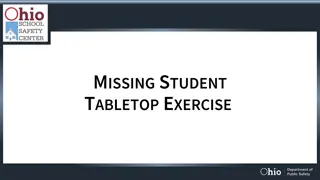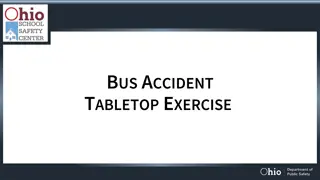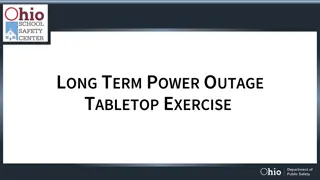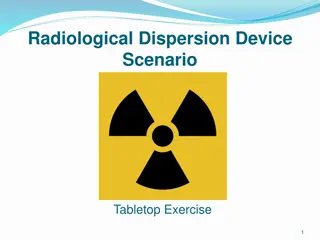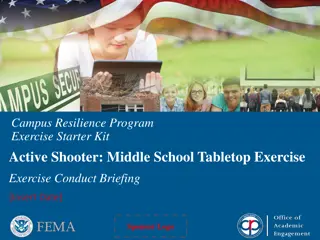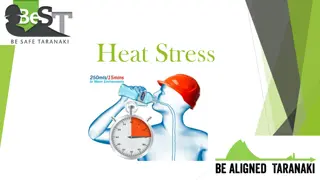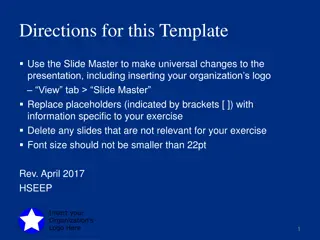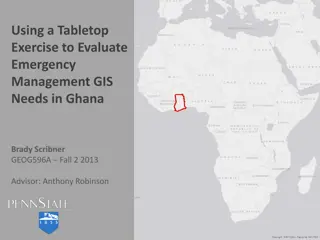Tabletop Exercise: Heat Event in Long-Term Care Facilities
This tabletop exercise focuses on preparing Long-Term Care/Assisted Living facilities for heat events, covering topics such as agenda, land acknowledgment, introduction, purpose, format, processes, and escalation procedures. The event aims to simulate and practice responses to heat emergencies while promoting open dialogue and improvement opportunities in a no-fault atmosphere.
Download Presentation

Please find below an Image/Link to download the presentation.
The content on the website is provided AS IS for your information and personal use only. It may not be sold, licensed, or shared on other websites without obtaining consent from the author.If you encounter any issues during the download, it is possible that the publisher has removed the file from their server.
You are allowed to download the files provided on this website for personal or commercial use, subject to the condition that they are used lawfully. All files are the property of their respective owners.
The content on the website is provided AS IS for your information and personal use only. It may not be sold, licensed, or shared on other websites without obtaining consent from the author.
E N D
Presentation Transcript
Tabletop exercise: Heat event Long-term Care/Assisted Living (LTC/AL) [date] 1
Agenda Land acknowledgment Overview Introduction Purpose Format Processes Tabletop exercise Closing 2
Land acknowledgement We are meeting today on the traditional and unceded territory of the Coast Salish peoples, including the territories of the Katzie, Kwikwetlem, Kwantlen, Tsawwassen, and Semiahmoo Nations. Source: www.johomaps.net 3
Introduction A guided discussion using a scripted event to ensure preparedness of LTC/AL facilities to heat plans Designed to promote free and open exchange of ideas and provide an opportunity to improve This is a training event and we would like to remind everyone of the importance of maintaining a no-fault atmosphere 4
Purpose Simulate activation and escalation to a heat event Standard, escalated and emergency measures Raise awareness of heat planning and resources Practice site coordination to a simulated heat event 5
Format Players Site-based leadership Key clinical and support staff Medical staff Scenarios Resident safety impacts Increasing temperatures Cooling pattern Heat warning 6
Process: Key triggers and actions Level Trigger Standard actions To be taken to prevent indoor temperatures from exceeding 26 C Escalated actions To be taken when temperatures approach or reach 26 C Emergency actions To be taken if the indoor temperature exceeds 26 C
Process: Escalation Indoor temperature < 26 C Continue with monitoring and standard measures Heat warning or extreme heat emergency anticipated Indoor temperature < 26 C Indoor temperature > 26 C Implement escalated measures Indoor temperature > 26 C Implement emergency measures Indoor temperature < 26 C Indoor temperature > 26 C Continue to monitor; return to escalated and standard measures as appropriate Contact Access, Care & Transitions if any of the following are true: Emergency measures have been exhausted Temperature remains 26 C or greater indoors Resident or staff safety is at risk
Tabletop exercise Respond to exercise events and information as if the emergency were real, unless otherwise directed by an exercise facilitator Parts of the scenario may seem implausible; recognize that the exercise has objectives to satisfy and may require incorporation of unrealistic aspects All external exercise communications will begin and end with the statement, EXERCISE, EXERCISE, EXERCISE If the exercise needs to end (i.e. true emergency), use the terminology NO DUFF to indicate the exercise is over / attention is required to a real event Next slide is the START of the exercise
Scenario 1: Increasing indoor temperatures Monday, July 18 14:00 Indoor temperatures are increasing and it is anticipated that they might reach 26oC 10
Scenario 1: Increasing indoor temperatures Monday, July 18 14:00 Indoor temperatures are increasing and it is anticipated that they might reach 26oC Discussion How are you preparing for: Staffing Hydration and cooling Resident relocation Managing internal temperatures Operational changes (food, recreation, etc.) Identify any equipment and supply needs Who are we notifying? At what point do we begin to implement escalated or emergency measures? 11
Scenario 2: Anticipated hot weather for the weekend Thursday, July 21 09:00 (+4 days) Indoor temperatures are approaching 26oC and are anticipated to continue to rise throughout the weekend Environment and Climate Change Canada issues a Heat Warning (2 or more consecutive days of daytime maximum temperatures are expected to reach 33 C or warmer and nighttime minimum temperatures are expected to be at 17 C or warmer) Fraser Health has forwarded the Heat Warning to all LTC/AL sites in the Fraser region The LTC/AL program has scheduled a coordination call for all sites within the Fraser Health region 12
Scenario 2: Anticipated hot weather for the weekend Thursday, July 21 09:00 (+4 days) Indoor temperatures are approaching 26oC and are anticipated to continue to rise throughout the weekend Discussion Describe key impacts you are monitoring for and the triggers for response escalation How are you preparing (now through weekend): Staffing Hydration and cooling Resident relocation Managing internal temperatures Operational changes (food, recreation, etc.) Who are you notifying? 13
Scenario 3: Impacts from heat event Friday, July 22 14:00 (+5 days) Indoor temperatures have exceeded 26oC Heat related illnesses are being observed among residents No longer meeting baseline staff requirements Power failure (i.e. HVAC system down as emergency generator cannot support) 14
Scenario 3: Impacts from heat event Friday, July 22 14:00 (+5 days) Discussion Describe key impacts you are monitoring and experiencing, and the triggers for response escalation When should external partners be involved (health authority, other LTC/AL sites, contractors)? How are you preparing for: Staffing concerns Hydration and cooling Resident relocation Managing internal temperatures Operational changes (food, recreation, etc.) Identify any remaining staff and resident safety risk to escalate to the health authority, following the implementation of emergency measures (i.e. HVAC failure) 15
Scenario 4: Cooling pattern Sunday, July 24 14:00 (+7 days) Discussion What is the trigger to stand down your response? How will you incorporate any identified changes to your heat plan? Where is your documentation being stored? Is psychosocial support required? When are your debriefs and after action reports scheduled? 16
Debrief 17
Resources ECAlertMe https://ecalertme.weather.gc.ca/home_en.php WeatherCAN app https://apps.apple.com/ca/app/weathercan/id1334221563 Alertable https://alertable.ca/#/
